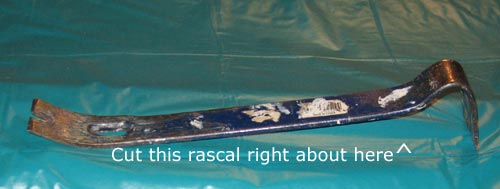

This is a continuation of the article Tools and Materials for Hanging Drywall.
Phillips drywall bit with dimple maker.
If you are going to use screws you really need to have a specially made bit with an attached dimple maker or you will run the screw head right through the paper on the surface of the drywall. Inexpensive models can be purchased for less than $3 that work almost as well as the more expensive $12-15 models.
Small hand rasp blade.
A small plane like rasp is very useful for removing the rough edges of a scored break. The tighter you fit the boards together, the less mud and effort you will use in the finishing process.
Drywall Lifter.
A drywall lifter is a small device that helps you jack the lower panel up tight against the upper panel while hanging the boards on the walls without breaking your back. If your project has any size to it or you think you may do this more than once, buy a couple of the commercial models. A very effective, inexpensive substitute is to cut the curved section off of a flat pry bar. Simply use an angle grinder to cut where the arrow is in the picture below, discard the right portion and use the left part as a drywall lifter.

Pencils.
A supply of pencils not pens or markers should be used for marking on the drywall. Any decent grade of paint will cover pencil marks with no problems. Pens and markers can bleed through several coats of even the best paint.
Dead-man optional.
If there are just two of you and there are ceilings involved a drywall jack of some type is very helpful. A simple one can be made from 2x4 stock. It is then used to hold that 63 pounds of wiggly drywall in place while you manage to get a few screws or nail in place to secure it.
Yet another option to get that weight off your head is to cut three short sections of 1X stock about a foot in length and drill a hole in the center. When you first put the wallboard in place, run a long screw through the hole in the board and into the ceiling joist. Three of those, equally spaced across the 8 foot span and near the center of the 4 foot span will hold an 8 foot sheet of drywall in place for hours.
Nails and/or Screws.
Your fasteners should not penetrate the wood framing by more than 1 1/8". 1 5/8" screws or nails are the most commonly used size and are usually priced the cheapest. By far screws have more holding power and result in fewer pops after finishing than nails do. Drywall was installed for many years before screws came into use so the final choice of which to use is completely up to you.
Scab boards.
Whether in new or existing construction I have yet to hang drywall where a few scab boards were not needed. Having a supply of pre-cut 46" scabs made from 2x2 or 1x2 stock and the nails or screws to attach them to the framing will make your installation go much smoother. We will explain how to use them in the installation article.